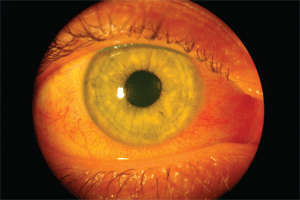 Q: I’m intrigued by the off-label use of Betadine 5% (povidone-iodine ophthalmic solution, Alcon) for adenoviral infection and even MRSA. What is its antimicrobial spectrum? Can this be done at home or in the office daily until a cure is established? Are there any caveats to using this approach?
Q: I’m intrigued by the off-label use of Betadine 5% (povidone-iodine ophthalmic solution, Alcon) for adenoviral infection and even MRSA. What is its antimicrobial spectrum? Can this be done at home or in the office daily until a cure is established? Are there any caveats to using this approach?
A: Povidone-iodine has a very broad spectrum—studies have confirmed high microbial kill rates when using a 5% sterile ophthalmic preparation.1 It’s been shown to be an effective anti-infective agent against Fusarium, Candida, Mycobacterium tuberculosis, as well as viruses, but the literature regarding its effectiveness against Acanthamoeba is conflicting.2
“The whole idea of the Betadine wash in adenoviral conjunctivitis is to reduce the viral load in the eye, which the Betadine wash accomplishes nicely,” says Ernie Bowling, O.D., M.S., of Gadsden, Ala. “I have been nothing short of amazed at the recovery of my patients when I use this treatment.”
Povidone-iodine is used off-label for management of adenoviral conjunctivitis/keratoconjunctivitis. The patient should be draped and gloves should be worn by the practitioner to avoid contamination and spread of disease. While protocols vary, a topical anesthetic is always instilled first because povidone-iodine causes stinging. The anesthetic is typically followed by a drop of a topical NSAID and then several drops of 5% povidone-iodine in both eyes.
“I have patients close their eyelids and move their eyes around to ensure widespread coverage,” says Tammy Than, O.D., M.S., associate professor at University of Alabama at Birmingham School of Optometry. She then swabs the eyelids with additional 5% povidone-iodine and, after two minutes, uses a sterile irrigating solution to thoroughly rinse the eyes. (Two minutes ensures a greater kill rate of organisms, she says.) “I then instill another drop of a topical NSAID and have the patient continue NSAID use for a few days.”

A typical viral conjunctivitis appearance. Notice the global conjunctival injection and glossy looking eye. Photo: Derek Cunningham, O.D.
Drs. Than and Bowling agree that a one-time application of povidone-iodine should be sufficient for alleviating the condition.
Because a topical anesthetic must be used, this should be an in-office procedure only, says Derek Cunningham, O.D., of Dell Laser Consultants, Austin. Using Betadine as an at-home remedy could be dangerous for several reasons, especially because Betadine is a trade name for different solutions containing povidone-iodine, “Many commercially available [non-ophthalmic] preparations can contain detergents that are disruptive to tissue and can cause considerable cornea and conjunctiva damage,” he says. “Time of exposure and possible adverse reactions need to be monitored [in office].”
Dr. Cunningham notes almost all published studies on povidone-iodine are from animal models or conjunctival isolates from normal eyes, and that there is a lack of well-controlled studies on the clinical effects of povidone-iodine mono-treatment on infected eyes.
“Although this off-label use of povidone-iodine has gained favor among many practitioners, it has not been embraced by the entire profession,” Dr. Than says. “There is a need for a well-designed study. If the findings are favorable, then we will be able to practice good, sound, evidence-based medicine and provide quick, effective relief for patients who can often suffer for weeks.”
1. Chronister DR, Kowalski RP, Mah FS, Thompson PP. An independent in vitro comparison of povidone iodine and SteriLid. J Ocul Pharmacol Ther. 2010 Jun;26(3):277-80.
2. Pelletier JS, Miller D, Liang B, Capriotti JA. In vitro efficacy of a povidone-iodine 0.4% and dexamethasone 0.1% suspension against ocular pathogens. J Cataract Refract Surg. 2011 Apr;37(4):736-6.

